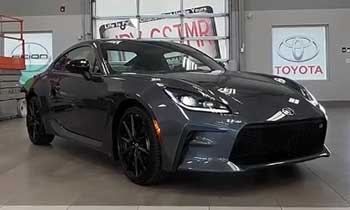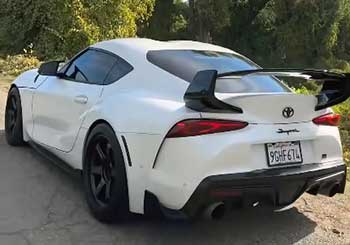
I’ve always been drawn to cars that stir the soul, and Toyota’s GR86 and GR Supra are two machines that do just that.
As a car enthusiast, I’ve spent time behind the wheel of both, marveling at their unique personalities. This article is my take on comparing these rear-wheel-drive legends, weighing their strengths, weaknesses, and what it’s like to live with them.
From performance to practicality, I’ll share my experiences, offer maintenance insights, and help you decide which Toyota sports car fits your driving dreams. Let’s hit the road and explore what makes these cars tick.
Comparison Table: Toyota GR86 Vs. Toyota Supra
| Feature | Toyota GR86 | Toyota Supra |
|---|---|---|
| Engine | 2.4L Flat-4, 228 hp | 3.0L Inline-6 Turbo, 382 hp |
| Transmission | 6-speed manual/auto | 6-speed manual/8-speed auto |
| 0-60 mph | 6.1 seconds | 4.3 seconds |
| Fuel Economy | 20/27 mpg (city/hwy) | 22/29 mpg (city/hwy) |
| Starting Price | $31,595 | $58,095 |
| Seating | 4 (2+2) | 2 |
| Cargo Space | 6.3 cu ft | 10.2 cu ft |
| Weight | ~2,800 lbs | ~3,400 lbs |
| Drive | Rear-wheel drive | Rear-wheel drive |
| Safety Rating | IIHS Top Safety Pick+ | Not rated by IIHS |
My Experience With Toyota GR86
I’ll never forget the first time I slid into the driver’s seat of a Toyota GR86. The cabin felt like a cockpit designed for one purpose: driving. The low-slung seat, the perfectly placed shifter, and the small steering wheel made me feel connected to the car before I even turned the key. On the road, the GR86 is a revelation.
Its 2.4-liter boxer engine, co-developed with Subaru, delivers 228 horsepower, enough to make it lively without overwhelming a novice like me on twisty backroads. The rear-wheel-drive setup and limited-slip differential let me nudge the tail out with confidence, especially with traction control off.
What struck me most was the GR86’s agility. It’s light—around 2,800 pounds—and feels like an extension of my body. On a mountain road near my home, I could flick it through corners with precision, the chassis communicating every nuance of the pavement.
The six-speed manual is a joy, with short, crisp throws that make every shift satisfying. But it’s not perfect for daily life. The cabin is snug, and the back seats are more decorative than functional—unless your passengers are kids or contortionists. Road noise creeps in on highways, and the infotainment system feels dated, with a clunky 7-inch screen.
I took the GR86 to a local autocross event, and it was a blast. Its nimble handling and predictable balance made it a star on tight courses. However, I noticed the engine’s torque dip at low revs, which required me to keep the revs high to stay in the powerband.
For a car priced around $31,595, it’s a steal for enthusiasts, but it’s not the most refined daily driver. Still, every drive left me grinning, daydreaming about the next set of curves.
Pros Of Toyota GR86

- Affordable Price Point: Starting at $31,595, the GR86 is one of the most accessible sports cars, offering pure driving fun without breaking the bank.
- Nimble Handling: Its lightweight chassis and rear-wheel-drive setup make it a corner-carving machine, perfect for autocross or winding roads.
- Manual Transmission Option: The six-speed manual is precise and engaging, enhancing the driver-focused experience.
- Safety Features: It earns an IIHS Top Safety Pick+ rating, with standard stability and traction control for added confidence.
- Tuner-Friendly Design: The GR86 has a robust aftermarket, with options for superchargers, exhausts, and suspension upgrades to boost performance.
- Classic Sports Car Feel: The low center of gravity and boxer engine give it a raw, mechanical connection that’s rare in modern cars.
- Reliable Engineering: Built with Subaru, it inherits Toyota’s reputation for durability, keeping maintenance costs reasonable.
The GR86’s affordability is its biggest draw. For under $32,000, you get a car that rivals pricier competitors like the Mazda MX-5 Miata in driving dynamics. Its handling is razor-sharp, thanks to a TORSEN limited-slip differential and a well-tuned suspension.
I loved how it danced through corners, feeling like a go-kart with just enough power to keep things exciting. The manual gearbox is a highlight, making every drive feel like an event. Plus, its safety rating gave me peace of mind, knowing it’s not just fun but also secure. The aftermarket support is a bonus, letting owners personalize their ride without voiding warranties.
Also read: My Thoughts on Acura ILX Vs. Honda Accord
Cons Of Toyota GR86
- Limited Power: The 228-hp engine feels underpowered at low revs, with a noticeable torque dip that demands high RPMs for spirited driving.
- Cramped Interior: The back seats are nearly unusable for adults, and front occupants may feel confined, especially taller drivers.
- Road Noise: Highway drives are loud, with tire and wind noise making long trips less comfortable.
- Outdated Infotainment: The 7-inch screen and basic interface lag behind modern systems, lacking wireless Apple CarPlay.
- Small Cargo Space: With only 6.3 cubic feet, the trunk struggles to accommodate more than a weekend’s worth of gear.
- Firm Ride: The sport-tuned suspension is great for handling but can feel harsh on rough roads, impacting daily comfort.
- No Convertible Option: Unlike the MX-5, the GR86 is strictly a coupe, limiting open-air driving enthusiasts.
The GR86’s engine is its biggest letdown. While 228 horsepower sounds decent, the torque dip makes it feel sluggish unless you’re wringing it out past 4,000 RPM. The cabin, while driver-focused, is tight—my 6-foot frame barely fit comfortably.
Long drives on the interstate were tiring due to the noise and stiff ride, and the tiny trunk meant I had to pack light. The infotainment system frustrated me with its slow response and lack of modern features. For a car this fun, these compromises are noticeable, especially if you’re using it as a daily driver.
Maintenance Tips For Toyota GR86
- Regular Oil Changes: Use 0W-20 synthetic oil every 6,000 miles to keep the boxer engine running smoothly and avoid sludge buildup.
- Tire Rotation and Alignment: Rotate tires every 5,000 miles and check alignment annually, as the GR86’s sporty handling can wear tires unevenly.
- Brake Maintenance: Inspect brake pads every 15,000 miles, especially if tracking the car, as spirited driving wears them quickly.
- Cooling System Checks: Flush the coolant every 30,000 miles to prevent overheating, critical for the high-revving engine.
- Air Filter Replacement: Replace the air filter every 15,000 miles to maintain performance and fuel efficiency.
- Check Differential Fluid: Change the differential fluid every 30,000 miles to ensure the limited-slip differential operates smoothly.
- Monitor Clutch Wear: For manual models, check clutch engagement every 20,000 miles, as aggressive driving can accelerate wear.
Maintaining the GR86 is straightforward, thanks to Toyota’s reliability. I stuck to synthetic oil changes every 6,000 miles, which kept the engine happy during my spirited drives. Rotating tires regularly saved me from uneven wear, especially after autocross sessions.
Brake pads needed checking often, as I burned through them faster than expected on twisty roads. The cooling system is crucial—overheating can be an issue if you push the car hard. Keeping the air filter fresh boosted responsiveness, and differential fluid changes ensured the rear end stayed planted. For manual drivers, clutch maintenance is key to avoid costly repairs.
My Experience With Toyota Supra
The Toyota Supra is a different beast entirely. When I first drove the GR Supra, its aggressive styling—sharp lines, wide stance, and low profile—made it feel like a supercar. The 3.0-liter turbocharged inline-six, borrowed from BMW, pumps out 382 horsepower, rocketing from 0-60 mph in 4.3 seconds.
The power was intoxicating; on an open highway, I felt the surge of torque at just 1,800 RPM, making passing effortless. The six-speed manual, introduced in later models, was a game-changer, with smooth rev-matching that made downshifts a breeze.
The Supra’s cabin is a step up, with premium materials and a driver-centric layout. The BMW-sourced infotainment, with an 8.8-inch screen, was intuitive, though I noticed some plasticky bits that didn’t match the $58,095 price tag.
On a track day, the Supra shone—its adaptive suspension and Brembo brakes handled high-speed corners with confidence. But daily driving revealed drawbacks: the two-seat layout limits practicality, and the low ground clearance (4.7 inches) made me wince over speed bumps. It’s a car that demands attention, both from you and everyone else on the road.
Pros Of Toyota Supra
- Powerful Engine: The 3.0L turbo inline-six delivers 382 hp and 368 lb-ft, offering thrilling acceleration and low-end torque.
- Smooth Ride: Adaptive suspension absorbs bumps better than the GR86, making it more comfortable for long drives.
- Manual Option: The six-speed manual with rev-matching adds engagement, rivaling the best sports car gearboxes.
- Larger Cargo Space: With 10.2 cubic feet, the trunk handles more luggage than the GR86, ideal for weekend trips.
- Advanced Tech: Features like wireless Apple CarPlay, adaptive cruise, and a JBL stereo elevate the driving experience.
- Track-Ready Performance: Brembo brakes and an active differential make it a circuit star, outpacing the GR86.
- Striking Design: Its bold, futuristic styling turns heads, setting it apart from more understated rivals.
The Supra’s power is its calling card. The inline-six feels effortless, whether merging onto highways or blasting through straights. I loved the smooth ride on long drives, a stark contrast to the GR86’s harshness. The manual gearbox, with its intelligent rev-matching, made me feel like a pro, even on tricky downshifts.
The cargo space was a pleasant surprise—I fit two suitcases for a weekend getaway. Tech like adaptive cruise and a crisp JBL stereo added luxury, while the track-ready setup let me push hard at a local circuit. The Supra’s design is pure drama, drawing stares everywhere.
Cons Of Toyota Supra

- High Price: Starting at $58,095, it’s nearly double the GR86’s cost, making it less accessible.
- Two-Seat Layout: No back seats limit practicality, unlike the GR86’s 2+2 configuration.
- BMW Influence: The heavy use of BMW parts, from the engine to the interior, dilutes its Toyota identity.
- Low Ground Clearance: At 4.7 inches, it scrapes on steep driveways and speed bumps.
- Maintenance Costs: BMW-sourced components mean higher repair and service expenses than the GR86.
- Less Nimble: At 3,400 pounds, it feels heavier than the GR86 in tight corners, sacrificing agility.
- Muted Exhaust: The engine lacks the aural drama expected from a sports car, especially in standard mode.
The Supra’s price stung. At nearly $60,000, it’s a big leap from the GR86, and I questioned if the performance justified the cost. The two-seat setup meant I couldn’t carry extra passengers, and the BMW-heavy interior felt less unique than I’d hoped.
Scraping the undercarriage on driveways was a constant worry. Maintenance costs gave me pause—BMW parts aren’t cheap, and service intervals felt pricier than the GR86. While the Supra excels on tracks, it’s less playful in tight corners, and the quiet exhaust disappointed my inner gearhead. It’s a fantastic car, but not without compromises.
Maintenance Tips For Toyota Supra
- Synthetic Oil Changes: Use 0W-20 synthetic oil every 5,000-7,000 miles to maintain the turbo engine’s performance.
- Turbo System Checks: Inspect the turbocharger every 20,000 miles for wear, as it’s critical to the engine’s power.
- Brake Inspections: Check Brembo brakes every 10,000 miles, especially after track use, to prevent costly rotor damage.
- Coolant Flush: Flush the cooling system every 30,000 miles to avoid turbo and engine overheating issues.
- Transmission Fluid: For manuals, change fluid every 40,000 miles; automatics need it every 60,000 miles.
- Tire Maintenance: Rotate tires every 5,000 miles and replace high-performance tires every 20,000 miles due to wear.
- Battery Health: Check the battery annually, as it’s tucked in the trunk and prone to drainage if not driven regularly.
The Supra’s maintenance is more involved due to its BMW roots. I found oil changes critical to keep the turbocharged engine smooth, and checking the turbo itself prevented potential headaches. The Brembo brakes needed frequent inspections after track days to avoid expensive repairs.
Coolant flushes were non-negotiable, as the engine runs hot under load. Transmission fluid changes kept shifts crisp, especially in the manual. High-performance tires wore quickly, so I budgeted for replacements. The battery, hidden in the trunk, needed regular checks to avoid being stranded. Staying proactive kept the Supra running like a dream.
Read more: My Thoughts on Acura Integra Vs. Honda Accord
Frequently Asked Questions (FAQ)
No, they’re distinct sports cars. The GR86 is a lightweight, four-seat coupe with a Subaru-built 2.4L boxer engine, focused on agility. The Supra is a two-seat, BMW-influenced car with a turbocharged inline-six, built for power and speed.
The GR86 isn’t officially discontinued, but rumors suggest Toyota may phase it out due to stricter emissions regulations and a shift toward electrified vehicles. No confirmed end date exists as of July 2025.
The GR86 starts at $31,595, while the Supra begins at $58,095. The price gap reflects the Supra’s premium features and performance, nearly double the GR86’s cost.
The “86” name honors the AE86 Corolla Levin/Sprinter Trueno, a 1980s rear-wheel-drive icon known for its handling and drifting prowess, inspiring the modern GR86’s design.
Conclusion: For Toyota GR86 And Supra
You’re at a crossroads, choosing between two Toyota legends. The GR86 is your pick if you crave affordable, raw driving fun—its nimble chassis and manual gearbox make every corner a thrill, perfect for enthusiasts on a budget. But if power and presence are your game, the Supra delivers with its turbocharged might and track-ready poise, though it comes at a premium.
I’ve loved driving both, but your choice depends on what sets your heart racing: the GR86’s playful spirit or the Supra’s commanding performance. Test-drive them, feel the difference, and let your passion decide.

